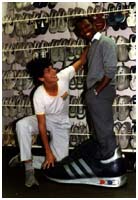 There is such an abundance of shoes out there that at times runners do not know where to begin. We will first discuss the various ideas behind shoes and why they were designed as well as the, in our opinion, over used word ‘pronation’. View the article ‘buying your first pair of running shoes’ in which we discuss the various shapes of your feet and a simple way to assess them, as well as the type of shoe best suited for your foot type.
There is such an abundance of shoes out there that at times runners do not know where to begin. We will first discuss the various ideas behind shoes and why they were designed as well as the, in our opinion, over used word ‘pronation’. View the article ‘buying your first pair of running shoes’ in which we discuss the various shapes of your feet and a simple way to assess them, as well as the type of shoe best suited for your foot type.
We will first mention the shoe that is aimed at most runners, the Normal Foot. The ‘catchword’ for this category is light to medium cushioned stability. These shoes would be aimed at a runner who is not doing high mileage and who is looking for a bit of stability which suits all foot types. This shoe is not for anyone with known or suspected bi-mechanical problems, and is heavier than 75Kg’s/185 lbs. The shoe need not be too cushioned and does not need too much stability.
Motion control – You either too in or way out
Too in – over pronation : You will tend to be more a Flat Foot runner. These shoes are for feet that roll inward too much, or over pronate.
They are built to reduce or control the excess inward rolling, pronation, action of the foot. The shoe tends to be built on a straight last. If you take a ruler, turn the shoe bottom up and place the ruler on the outer sole, the toe area of the shoe will not turn away much from the ruler. The shoes are designed to be rigid and would not offer too much cushioning. In this instance your foot plays a major role in shock absorption during the roll of your foot. Unfortunately, the shoe will tend to be more heavy because of the features it offers. The key to the shoe ‘stabilty and control’.
Way out – supination : You will tend to be more a High-Arched runner. Your foot does not absorb sufficient shock and thus needs assistance with cushioning.
Cushioned shoes with plenty of flexibility to encourage foot motion are recommended. The shoe tends to be built on a curve last. If you take a ruler, turn the shoe bottom up and place the ruler on the outer sole, the toe area of the shoe will turn away from the ruler. The motion-control of this shoe would be one that does not allow you to roll outwards, supinate. Shoes that reduce foot mobility inwards are a big ‘no no’.
With that explained, we shall shortly be presenting the various brand names out there who make shoes specifically to suit what has been mentioned above.
* Pronation and the mechanisms of running injuries
Future articles :
* Shoes, shoes,everywhere and not a foot to spare. Part 2
* More on shoe tips and which category suits you
* Shoe terms and jargons explained
Also see the Article relating to shoes
Leave a Reply